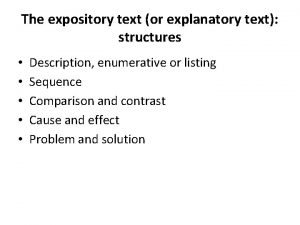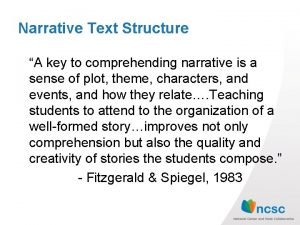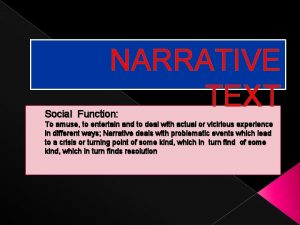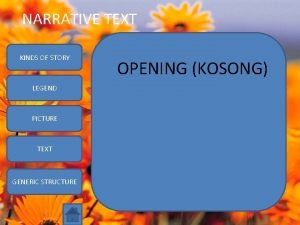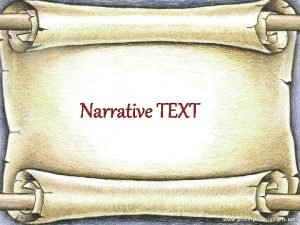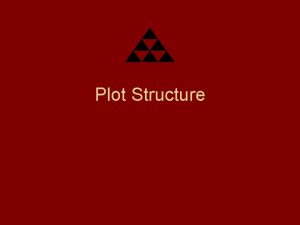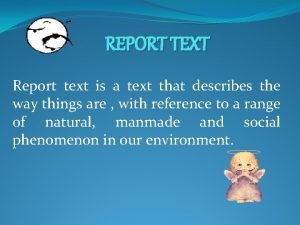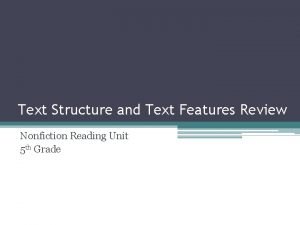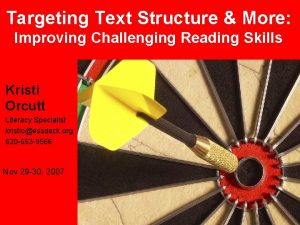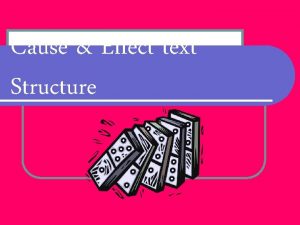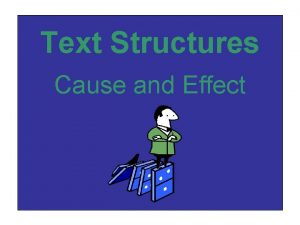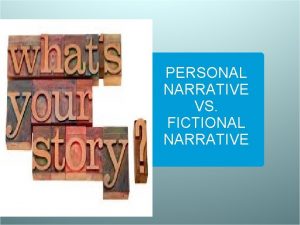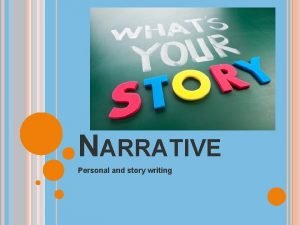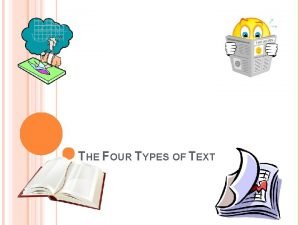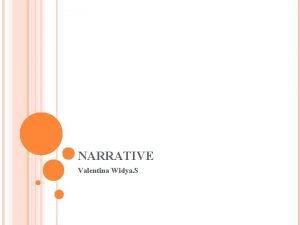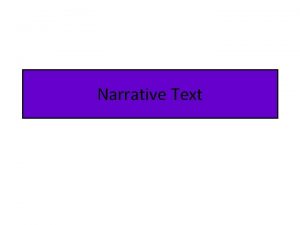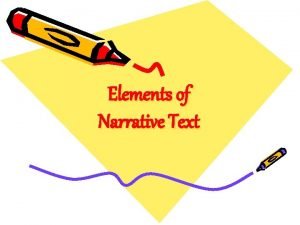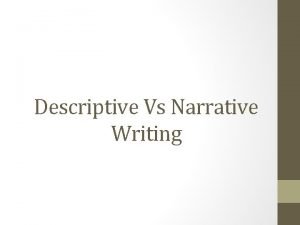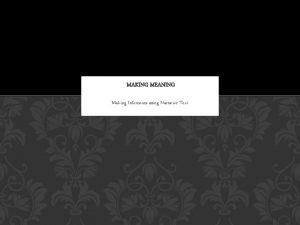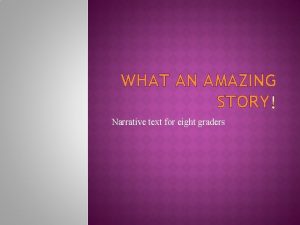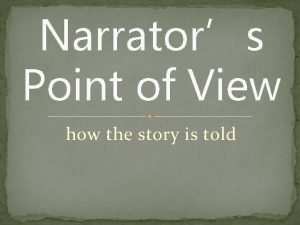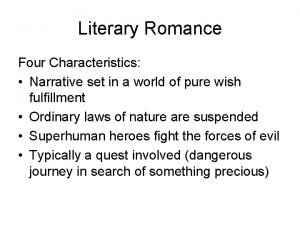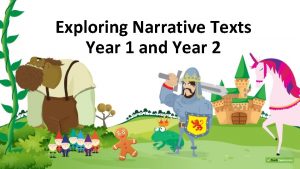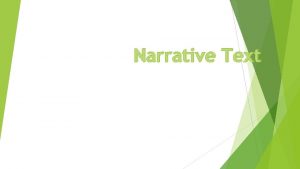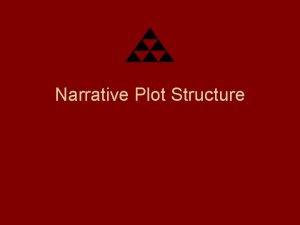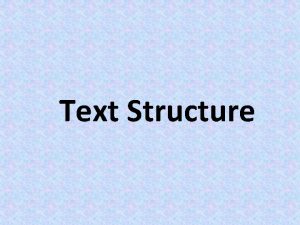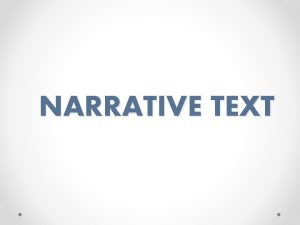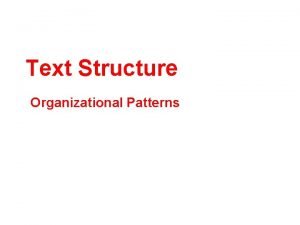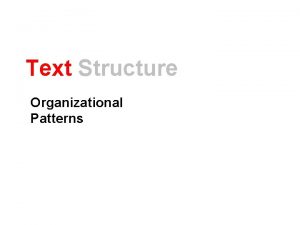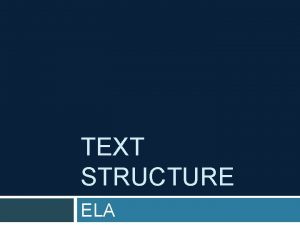Narrative Text Structure A key to comprehending narrative
































- Slides: 32

Narrative Text Structure “A key to comprehending narrative is a sense of plot, theme, characters, and events, and how they relate…. Teaching students to attend to the organization of a well formed story…improves not only comprehension but also the quality and creativity of stories the students compose. ” Fitzgerald & Spiegel, 1983

5 Elements of Narrative Structure Plot Theme Elements of Narrative Structure Point of View Characters Setting

Plot • Sequence of events involving characters in conflict situations. • Plot is based on the goals of one or more characters and the processes they go through to attain these goals. • Beginning, middle, end OR • Introduction, problem, and resolution

Plot Development 1. A problem: Usually presented at the beginning of the story 2. Roadblocks: Throughout the story, characters face roadblocks as they attempt to solve the problem 3. The high point: When the problem is about to be resolved 4. Solution: The problem is solved and the roadblocks are overcome

Plot Story Frame In this story, a problem begins when _______ After that, ______________ Next ________________ Then ________________ The problem is solved when _______ The story ends when __________

Help students understand the plot • Look for the information included in the introduction of a story: time, place, circumstances, main characters. • Look for the series of incidents where main characters go about achieving goals. • Call attention to how the goals are achieved or not achieved in the conclusion, and the high point of the action. • Make time lines of the story.

Characters • The people or personified animals who are involved in the story. • Fully developed characters have many character traits • • Appearance Action Dialogue Monologue

Character Analysis Frame In the story ___________ by _________ the major character is ____________ who is ______ Another main character is ________ The problem that the major character faces is that ________________ The story ends with ___________ The lesson I learned from reading was that __ ___________________

Help students identify characters • List characters, noting physical and personality traits. • Point out how authors reveal personality traits through character thoughts, behavior or language. • Identify the main characters’ goals and how these goals guide the story.

Setting Components of setting: • Location • Weather • Time Period • Time of Day

Setting Frame This story takes place ____________________________ I know this because the author uses the words __________________ Other clues that show when and where the story take place are ____________________________

Help students identify key aspects of setting • Find words and phrases that signal the time and place a story occurs. • Read the beginnings of stories aloud noting the clues for time and place.

Point of View First Person – Story is told through eyes of one person – Reader experiences story as the narrator views it – Found mostly in picture books Third Person – Used so readers can know the viewpoint of one character – The author is godlike: sees and knows all – Found mostly in chapter books

Theme • The underlying meaning of a story. • Truths about human nature. – Characters’ emotions and feelings – They can be explicit (stated openly) or implicit (suggested)

Strategies to Teach Narrative Text Structure • Story Map Graphic Organizers • Probable Passages • Story Impressions

Story Maps Setting Theme Sol uti on Ch ara cte rs Problem

Story Maps Climax Middle Beginning End

Probable Passages • Probable passages is a strategy that encourages students to predict the content of selections to be read. • They create a predictive passage and then revise it based on their understanding of key elements of story structure.

Probable Passage Template Name ________________________ Date __________ Probable Passages Concept Frame Setting Character Problem Solution Ending Passage Form The story takes place ___________________ is a character in the story who ________________. A problem occurs when _________________________. After that, __________________________________. Next, ____________________________________. The problem is solved when ___________________________. The story ends with _______________________________.

Step 1: Activating Prior Knowledge • Ask students to identify story elements from previous books they have read – Where and when did the story take place? – What happened as a result of the character’s actions • Have students discuss how the characteristics of the story helped them to understand the story – How did you learn about the characters? – How did you gather information about the setting?

Step 2: Before Reading Word Categorization • Predetermine terms that are significant to students’ comprehension of the story – Relate to elements of the story – Unknown words • Discuss what the words mean and how they are related • Students collaborate and place the words under the correct frame

Teacher Selected Key Terms from Chrysanthemum by Kevin Henkes • • • Chrysanthemum school Victoria unhappy perfect dreadful • • • tease flower parents Mrs. Twinkle name baby

Key Terms from Chrysanthemum Categorized by Story Elements Setting Character Problem Solution Ending school Chrysanthemum Mrs. Twinkle Parents Victoria dreadful unhappy tease perfect name flower Baby

Step 3: Before Reading Completion of Story Frame • Students now apply their understanding of story grammar by filling in the story passage frame using the categorized terms • Be sure to model and think aloud to scaffold the process for students

Sample Before Reading Story Frame for Chrysanthemum The story takes place at home after school. Chrysanthemum is a character in the story who is dreadfully unhappy because she is being teased. A problem occurs when Chrysanthemum goes to play with her friend Victoria. After that, her parents tell her she should be doing her homework for Mrs. Twinkle. Next, Chrysanthemum and Victoria try to come up with a name for her baby sister. The problem is solved when they decide to go outside and play. They see pretty flowers and decide it would be perfect to name the baby after one of the flowers. The story ends with the girls deciding to name the baby Daisy.

Step 4: Read the Selected Text • Students read the selected text and make continuous comparisons between their predictions and what actually happens in the story

Step 5: After Reading Revision of the Story Frame Example The story takes place at school. Chrysanthemum is a character in the story who loves her name and thinks it is absolutely perfect because her parents tell her so. A problem occurs when Chrysanthemum goes to school and Victoria and the other students tease her and tell her she is named after a flower. After that, she thinks her name is dreadful and she is unhappy with her name. Next, Chrysanthemum meets the new music teacher, Mrs. Twinkle. The problem is solved when Mrs. Twinkle tells the class that she is also named after a flower, a delphinium, and if she has a baby girl, she will name her Chrysanthemum. The story ends with Chrysanthemum thinking her name is not dreadful, but absolutely perfect.

Story Impressions 1. Provide introduction: “Today we’re going to make up what we think this story could be about. ” 2. Direct students to the list of key concepts by saying, “Here are some clues about the story we’re going to read. We’re going to use these clues to write our own version of the story. After that, we’ll read the story together to see if the author had ideas similar to ours. ” 3. After student read through the list of clues, brainstorm and record how the ideas might connect. 4. Using the brainstormed ideas, a class story is developed that ties together the clues. 5. The students read the author’s actual story and discuss how their story compares.

Sample Story Impression Word List for Make Way for Ducklings by Mc. Closkey Mr. & Mrs. Mallard Public garden Peanuts Hatched Highway Family of Ducks Policeman Ducklings Swim Waddled Speeding Cars Live

Review You have learned about the various narrative text structures and explored some possible graphic organizers and strategies for teaching these text structures.

Your Turn! Now ask yourself: • What are the common text structures for narrative text? • What are some effective ways to teach students the organization of narrative text?

Check for Understanding • What are the common text structures for narrative text? – Plot, characters, setting, point of view, theme • What are some effective ways to teach students the organization of narrative text? – Story map graphic organizer, Probable Passage, Story Impressions
 What is an example of a text-to-media connection?
What is an example of a text-to-media connection? Nature of expository text vs narrative text
Nature of expository text vs narrative text Narrative vs expository text
Narrative vs expository text Narrative text structures
Narrative text structures Contoh social function
Contoh social function Generic structure of legend
Generic structure of legend What do you know about narrative
What do you know about narrative Beginning climax conclusion
Beginning climax conclusion Report text structure and example
Report text structure and example Poster showing the timeline of development of gadgets
Poster showing the timeline of development of gadgets Identifying text structure #1 answer key
Identifying text structure #1 answer key Types of text structure cause and effect
Types of text structure cause and effect Cause and effect text structure
Cause and effect text structure Cost structure example business model canvas
Cost structure example business model canvas Key partners key activities key resources
Key partners key activities key resources Personal narrative vs short story
Personal narrative vs short story Personal narrative vs fictional narrative
Personal narrative vs fictional narrative Example of narrative text type
Example of narrative text type News item text generic structure
News item text generic structure Elements of narrative writing
Elements of narrative writing What is the social function of the story
What is the social function of the story What is the purpose of narratives
What is the purpose of narratives Elements of a narrative text
Elements of a narrative text What is narrative writing
What is narrative writing Generic structure mouse deer and crocodile
Generic structure mouse deer and crocodile Kinds of narrative text
Kinds of narrative text Meaning
Meaning Narrative text
Narrative text Narrative text hansel and gretel
Narrative text hansel and gretel Example of narrative text
Example of narrative text Narrative text example
Narrative text example The green knight narrative text
The green knight narrative text Language features of a narrative
Language features of a narrative


